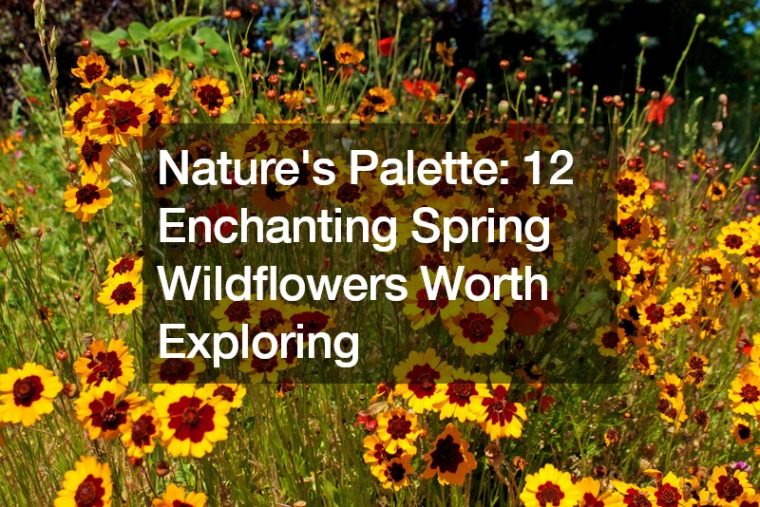
While spring is in full swing, nature’s canvas comes to life with a burst of colors and fragrances. Spring is a magical time of year when the woodland floors and meadows are adorned with a plethora of wildflowers, each one a testament to the beauty and resilience of the natural world. In this blog post, we’ll explore twelve captivating blooms worth discovering and appreciating.
Lady’s Smock:
Delicate and lilac-hued, Lady’s Smock is a spring specialist found in wet areas like woodlands and meadows. Its four-petaled flowers with darker lilac veins offer a picturesque sight, while its high vitamin C content makes it a potential remedy or culinary addition.
Greater Stitchwort:
Nestled in hedgerows and woodlands, the Greater Stitchwort boasts clusters of small white flowers with a yellow center. Its unique petal structure, resembling ten petals but actually comprising five split petals, makes it a fascinating find for nature enthusiasts.
Lesser Celandine:
Painting the countryside with its cheerful yellow blooms, the Lesser Celandine is a common sight in early spring. Often mistaken for buttercups, its heart-shaped leaves and low-growing habit create a golden carpet across meadows and woodland edges.
Lords and Ladies:
With its striking green flowers and dramatic leaves, Lords and Ladies add a touch of intrigue to the woodland floor. Beware, though, for this captivating plant is highly poisonous and should be admired from a distance.
Wood Anemone:
One of the first spring flowers to bloom, the Wood Anemone carpets ancient woodlands with its delicate white or pink-tinted blossoms. An indicator of ancient woodland sites, its presence heralds the arrival of spring’s gentle warmth.
Bluebell:
Often regarded as a favorite among spring blooms, the Bluebell blankets woodlands with its enchanting violet-blue hues. Its graceful, drooping flowers and glossy foliage create a magical atmosphere, inviting wanderers to lose themselves in nature’s beauty.
Marsh Marigold:
Thriving in wet habitats, the Marsh Marigold is a beacon of golden brilliance amidst marshes and damp meadows. Its large, bright flowers attract a myriad of pollinators, adding vibrancy to waterlogged landscapes.
Primrose:
A harbinger of spring’s arrival, the Primrose greets the season with its buttery yellow petals and compact rosette of leaves. Edible and delightful, these early bloomers symbolize the promise of warmer days ahead.
Dog Violet:
Hiding amidst woodland undergrowth, the Dog Violet reveals its shy, purple-hued flowers to attentive observers. With its unique petal arrangement and heart-shaped leaves, this diminutive plant adds a touch of elegance to its surroundings.
Wood Sorrel:
With its delicate white petals adorned with purple veins, Wood Sorrel graces shady woodland spots with its lemony-tasting leaves. A delightful snack for foragers, its presence adds a tangy zest to springtime walks.
Cow Parsley:
Blanketing roadsides and hedgerows with its frothy white blooms, Cow Parsley, also known as Queen Anne’s Lace, creates a vision of ethereal beauty. Its fern-like leaves and distinctive flower clusters make it a quintessential springtime sight.
Forget-Me-Not:
Tiny yet unforgettable, the Forget-Me-Not enchants with its clusters of bright blue blossoms. Whether nestled in woodland clearings or dotting the edges of streams, these delicate flowers serve as a poignant reminder of nature’s enduring charm.
Tips for Cultivating Wildflower Meadows
Now that you’ve been introduced to the enchanting array of spring wildflowers, why not bring a piece of this natural symphony into your own backyard? Cultivating a wildflower meadow is not only a rewarding endeavor but also a way to support local pollinators and enhance biodiversity. Here are some tips to get you started:
1. Choose the Right Location: Select a sunny spot in your garden or yard that receives at least six hours of sunlight per day. This will ensure optimal growing conditions for most wildflower species.
2. Prepare the Soil: Before sowing your wildflower seeds, it’s essential to prepare the soil properly. Remove any existing vegetation and loosen the soil to a depth of about six inches. This will help the seeds establish a strong root system.
3. Select Your Seed Mix: Consider purchasing bulk wildflower seeds to create a diverse and vibrant meadow. A mix of annuals and perennials will provide continuous blooms throughout the spring and summer months.
4. Sow with Care: Scatter the seeds evenly over the prepared soil, taking care not to bury them too deeply. Lightly press the seeds into the soil surface to ensure good seed-to-soil contact.
5. Water and Mulch: After sowing, gently water the area to settle the seeds into the soil. Apply a thin layer of mulch to help retain moisture and suppress weed growth.
6. Patience is Key: While it may be tempting to expect immediate results, wildflower meadows take time to establish and flourish. Be patient and allow nature to work its magic.
7. Provide Maintenance: Once your wildflowers have germinated, continue to water them regularly, especially during dry spells. Remove any weeds that may compete with the wildflowers for nutrients and space.
Final Thoughts
As we marvel at the kaleidoscope of colors and forms that adorn the landscape during spring, let us take a moment to appreciate the intricate beauty of these wildflowers. From their delicate petals to their ecological importance, each bloom contributes to the rich tapestry of life surrounding us. So, keep an eye out for these enchanting treasures of nature’s palette, and let their beauty inspire awe and wonder in your heart.
.

